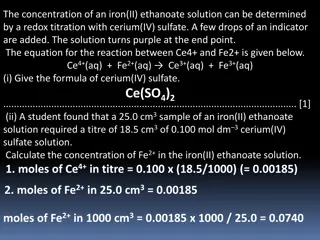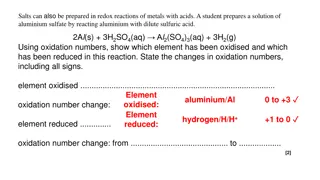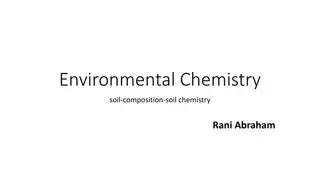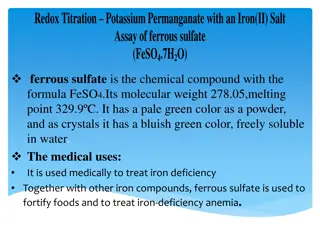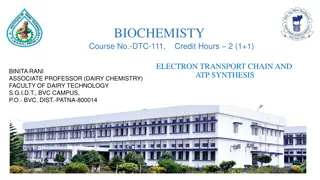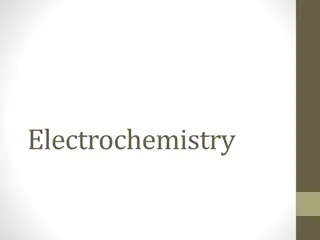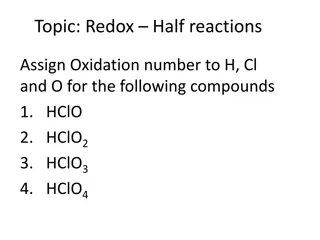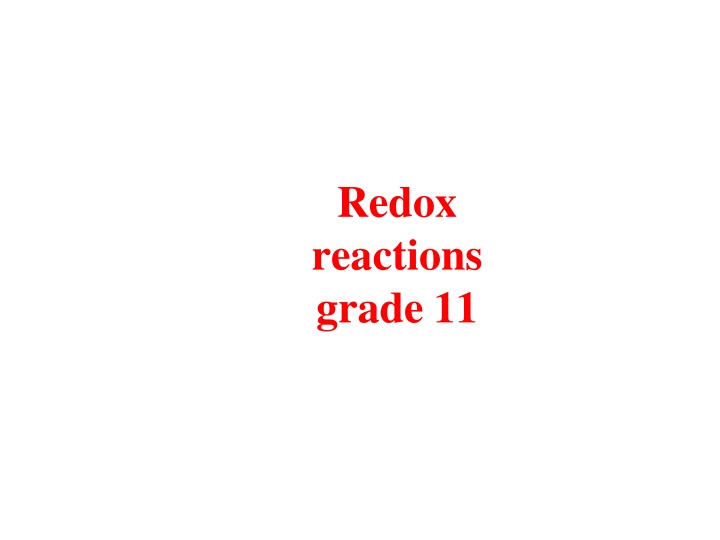
Oxidation and Reduction Reactions in Chemistry
Explore the concepts of oxidation and reduction reactions, also known as redox reactions, in chemistry. Learn how electrons are transferred between atoms, the definitions of oxidation and reduction, and examples of these reactions. Discover the crucial role of oxygen and hydrogen in these chemical processes. Unravel the fundamental principles behind the development of oxidation and reduction reaction concepts.
Download Presentation

Please find below an Image/Link to download the presentation.
The content on the website is provided AS IS for your information and personal use only. It may not be sold, licensed, or shared on other websites without obtaining consent from the author. If you encounter any issues during the download, it is possible that the publisher has removed the file from their server.
You are allowed to download the files provided on this website for personal or commercial use, subject to the condition that they are used lawfully. All files are the property of their respective owners.
The content on the website is provided AS IS for your information and personal use only. It may not be sold, licensed, or shared on other websites without obtaining consent from the author.
E N D
Presentation Transcript
Redox reactions grade 11
Oxidation-Reduction Reactions oxidation-reduction reactions are also called redox reactions all redox reactions involve the transfer of electrons from one atom to another spontaneous redox reactions are generally exothermic, and we can use their released energy as a source of energy for other applications Tro - Chapter16 2
Development of oxidation and reduction reaction concept 1. Reaction of reduction oxidation based on releasing (lossing) and gaining of oxygen a. Oxidation reaction Oxidation reaction is a reaction of gaining (capturing) of oxygen by a substance Example : CO2(g) 2P2O5(s) + 2H2Og) CH4(g)+ 2O2(g) P4(s)+ 5O2(g) b. Reduction reaction Reduction reaction is oxide compound Example: CuO(s) Fe2O3(s) a reaction of releasing (losing) of oxygenfrom a + H2(g) + 3CO(g) Cu(s)+ H2O(g) 2Fe(s)+ 3CO2(g)
Development of oxidation and reduction reaction concept 1. Reaction of reduction oxidation based on releasing (lossing) and gaining of oxygen a. Oxidation reaction Oxidation reaction is a reaction of gaining (capturing) of oxygen by a substance Example : CO2(g) 2P2O5(s) + 2H2Og) CH4(g)+ 2O2(g) P4(s)+ 5O2(g) b. Reduction reaction Reduction reaction is oxide compound Example: CuO(s) Fe2O3(s) a reaction of releasing (lossing) of oxygen from a + H2(g) + 3CO(g) Cu(s)+ H2O(g) 2Fe(s)+ 3CO2(g)
What do you mean by oxidation and reduction ? Oxidation can be defined as addition of oxygen/electronegative element to a substance or removal of hydrogen/ electropositive element from a substance. Reduction can be defined as removal of oxygen/electronegative element from a substance or addition of hydrogen/ electropositive element to a substance. 5
Oxidation and ReductionAnother Def in order to convert a free element into an ion, the atoms must gain or lose electrons of course, if one atom loses electrons, anothermust accept them reactions where electrons are transferred from one atom to another are redox reactions atoms that lose electrons are being oxidized, atoms that gain electrons are being reduced 2 Na(s) + Cl2(g) 2 Na+Cl (s) Na Na+ + 1 e Cl2 + 2 e 2Cl reduction oxidation 6
What is an oxidizing and reducing agent ? Oxidising agent: a reagent which increases the oxidation number of an element of a given substance. These reagents are called oxidants. Reducing agent: a reagent that lowers the oxidation number of a given element . These reagents are also called reductants. 7
OxidationReduction oxidation and reduction must occur simultaneously if an atom loses electrons another atom must take them the reactant that reduces an element in another reactant is called the reducing agent the reducing agent contains the element that is oxidized the reactant that oxidizes an element in another reactant is called the oxidizing agent the oxidizing agent contains the element that is reduced 2 Na(s) + Cl2(g) 2 Na+Cl (s) Na is oxidized, Cl is reduced Na is the reducing agent, Cl2 is the oxidizingagent 8
Oxidation and Reduction A Better Definition oxidation occurs when an atom s oxidation state increases during a reaction reduction occurs when an atom s oxidation state decreases during a reaction CH4 + 2 O2 CO2 + 2H2O -4 +1 0 +4 2 +1 -2 oxidation reduction 9
Will a Reaction Take Place? reactions that are energetically favorable are said to be spontaneous they can happen, but the activation energy may be so large that the rate is very slow the relative reactivity of metals can be used to determine if some redox reactions are spontaneous 10
Electron transfer reactions Place a strip of metallic zinc in an aqueous solution of copper nitrate , for about one hour. You may notice that the strip becomes coated with reddish metallic copper and the blue colour of the solution disappears. Formation of Zn2+ ions among the products can easily be judged when the blue colour of the solution due to Cu2+ has disappeared. If hydrogen sulphide gas is passed through the colourless solution containing Zn2+ ions, appearance of white zinc sulphide, ZnS can be seen on making the solution alkaline with ammonia. The reaction between metallic zinc and the aqueous solution of copper nitrate is :- In this reaction , zinc has lost electrons to form Zn2+and, therefore, zinc is oxidised. Evidently, now if zinc is oxidised, releasing electrons , copper ions is reduced by gaining electrons from zinc. 11
At this stage we may investigate the state of equilibrium for the reaction represented by equation . For this purpose, let us place a strip of metallic copper in a zinc sulphate solution. No visible reaction is noticed and attempt to detect the presence of Cu2+ ions by passing H2S gas through the solution to produce black colour cupric sulhpide. CuS, does not succeed. Cupric sulphide has such a low solubility that this is an extremely sensitive test. Cu2+ cannot be detected. Hence the equilibrium For the reaction favours the products over the reactants. 12
This suggests that we might develop a table in which metals and their ions are listed on the basis of their tendency to release electrons just as we do in the case of acids to indicate the strength of the acids. As a matter of fact we have already made certain comparisons. By comparison we have come to know that zinc releases electrons to copper and copper releases electrons to silver and therefore electron releasing tendency is in the order Zn>Cu>Ag . 13
2. Reduction oxidation reaction based on electron transfer a. Oxidation reaction Oxidation reaction is a reaction of electron releasing (lossing) from a substance. Example: Na Mg Cu Na++ e Mg2++ 2 e Cu2++ 2 e b. Reduction reaction Reduction reaction is a reaction of electron gaining by a substance. Example: Cl2+ 2e S + 2 e 2Cl S2
Stock notation Stock notation is the notation used where the oxidation state of the element is represented by roman numerals. Tro - Chapter16 15
IUPAC Nomenclature The compound that is formed by the elements have more than one type of oxidation number , its name diferentiated by the Roman number writing in the bracket in the back of that element name. The Roman number shows the value of oxidation number of that element. The compound that is formed by the element only has one type of oxidation number, the Roman number does not need writen. This IUPAC nomenclature applies in both ionic and covalent compounds. Examples IUPAC name of binary covalent compound: CO : carbon(II) oxide CO2 : carbon(IV) oxide P2O3 : phosphorus(III) oxide (oxidation number of P = +3) N2O5 : nitrogen(V) oxide Cl2O7 : chlorine(VII) oxide (oxidation number of C = +2) (oxidation number of C = +4) (oxidation number of N = +5) (oxidation number of Cl = +7)
Oxidation state For reactions that are not metal + nonmetal, or do not involve O2, we need a method for determining how the electrons are transferred chemists assign a number to each element in a reaction called an oxidation state that allows them to determine the electron flow in the reaction Basically oxidation number denotes the oxidation state of the element in a compound according to a set of rules formulated on the basis that electron fair in a covalent bond belongs entirely to the more electrovalent bond. 17
Oxidation Numbers Oxidation is the loss of electrons; Reduction is the gain of electrons Oxidation and reduction go together. Whenever a substance loses electrons and another substance gains electrons Oxidation Numbers are a system that we can use to keep track of electron transfers
Common Oxidation States Chemical species Oxidation state and remarks Any element eg Fe, O2 , S8 zero -2 except in peroxides example H2O2 or Na2O2 then oxygen atom has Oxygen in any compound oxidation state of -1 or in F2O , then oxygen atom has oxidation state of +2 Fluorine in any compound -1 being most electronegative +1 except in metal hydrides example NaH then hydrogen atom has oxidation state of -1 as metals have a greater tendency to lose Hydrogen in any compound electrons Chlorine, bromine, iodine -ve oxidation state if bonded to less electronegative element eg NaCl; then Cl = -1. +ve oxidation state if bonded to more electronegative element eg ClO-, then Cl = +1; ClO3-, then Cl = +5
Oxidation Number Oxdidation number is a number that states electrical charge possessed by each one element atom in the molecular compound or the ion. In the molecules of ionic compound, electrical charge contained element atom can be raised by transfering of electrons. In the formation of ionic bond: -Metal atom losses electron to form the positive ion. -Nonmetal atom gains electron to form the negative ion. In the molecule of MgF2, consist of Mg2+ ion with charge of 2+ dan F-ion with charge of 1 Said that in the molecule of MgF2, oxidation number of Mg is +2, and oxidation number of F is -1. In the molecule of covalent compound, the raising of the electrical charge each element atom is caused by its existence the difference of electronegativity of element, so that occur polarization covalent bond. In the polar covalent compound, the more electronegative atom become more negative charge and the other atom become more positive charge. In the polar covalent compound of H2O, H contain 1+ and O contain 2
Determining Oxidation Numbers of Elements The oxidation number of an element in the molecule or in the ion, by use the rules of oxidation numbers can be determined. Write down the molecular or ionic formula which will be determined oxidation number its element and between one atom of element and the others, given enough space. Write each oxidation number of elements in below it and write x for element that will be determined its oxidation number. Use the rules of oxidation number, that is rule of number 7 or 8, for determine x value. Example: Determine the following element oxidation number a. S in molecule of H2SO4 2 2 7 : Molecule of H2SO4 Ion of Cr2O72 : a. oxidation number of S in H2SO4 b. oxidation number of Cr in Cr2O72 Solution : b. Cr in ion of Cr O Given Find
Rules for determining oxidation number (1) In elements in the free or the uncombined state each atoms bears an oxidation number of zero. (2)For ions composed of only 1 atom the oxidation number is equal to the charge on the ion. (3)For oxygen in the case of superoxide's and peroxides oxidation state is assigned to oxygen as -1 or ( ). 09/25/15 22
(4)The second exception with oxygen is with the fluorides and di-fluorides here the oxygen has an oxidation state of +2 and+1. (5)The number assigned to oxygen will depend upon the bonding state of oxygen but this will have a positive number. (6)the oxidation state of hydrogen is +1, except when it is bonded with elements with binary compounds. When it is bonded with lithium , beryllium it has the oxidation state of -1. 23
(7)In all its compounds fluorine has an oxidation state of -1.other halogens like chlorine , bromine and iodine have also the oxidation state as -1.except oxoanions and oxoacids. (8)The algebraic sum of the oxidation number of all the atoms in a compound must be zero. In polyatomic ions the algebraic sum of all the oxidation numbers of atoms of the ion must be equal to the charge on the ion. 24
Oxidation Number basic Rules 1. Oxidation number of free elements Free elements (include molecular elements: H2, O2, O3, N2, F2, Cl2, Br2, I2, P4, S8) have oxidation number of 0 (zero). 2. Oxidation number of fluorine In its compounds, oxidation number of F always 1. 3. Oxidation number of hydrogen In its compounds, oxidation number of H always +1. Except, hydrogen in the hydride compounds (compound of H with metal), oxidation number of H, is 1 Example: In the compound of H2O, NH3, H2S, HCl, HNO3,H2SO4,oxidation number of H, is +1 In the hydride compound, like LiH, NaH, MgH2, oxidation number of H, is 1
Rules for Assigning Oxidation States 5. in their compounds, nonmetals have oxidation states according to the table below nonmetals higher on the table take priority Nonmetal F Oxidation State -1 Example CF4 CH4 CO2 CCl4 CS2 NH3 H +1 O -2 Group 7A -1 Group 6A -2 Group 5A -3 26
A. number change a. Oxidation reaction Oxidation reaction is a chemical reaction which is accompanied by increasing of oxidation number. Example: Al(s) Al3+ (aq) Reduction oxidation reaction based on oxidation S2-(aq) S(s) b. Reduction reaction Reduction reaction is a chemical reaction which is accompanied by decreasing of oxidation number. Example: Sn4+(aq) Cl2(g) Sn2+(aq) 2 Cl- (g)
Generally, metallic elements of group B has oxidation number more than one type. Example: b. Table 8.1. Oxidation numbers of several elements of group B Elements of group B Name Symbol Zn Silver Ag Copper Cu Gold Au Iron Fe Lead Pb Oxidation numbers Zink +2 +1 +1, +2 +1, +3 +2, +3 +2, +4 6. Oxidation number of monoatomic ion Oxidation number of mono atomic ions is equal to the charge on that ion Example: Na+ ion has oxidation number of +1 Ba2+ ion has oxidation number of +2 Fe3+ ion has oxidation number of +3 Cl ion has oxidation number of 1 S2 ion has oxidation number of 2
7. The sum of oxidation number of element atoms in a compound molecule is equal to 0 (zero) o. n. of element in compound molecule = 0 Example: H2O (o.n. of H x 2) + (o.n. of O x 1) {(+1) x2} + {(-2) x 1} {+2} + {-2} =0 =0 =0 8. The sum of oxidation number of element atoms in a polyatomic ion is equal to the charge on that ion. o. n. of element in ion = charge of ion Example: OH (o.n. of O x 1) + (o.n. of H x 1) {(-2) x 1} + {(+1) x 1} {-2} + {+1} =-1 =-1 =-1
a. H2SO4 o. n. H = +1, o. n. O = 2, O4 2 o. n. S = x H2 S x +1 o. n. element in molecule = 0 ( 2 x o. n. H) + (1 x o.n. S) + (4 x o.n. O) = 0 { 2 x (+1 ) } + { 1 x (x ) } + { 4 x ( 2) =0 ( +2) + (x) + ( 8) = 0 x = +8 2 x = +6 The oxidation number of S in H2SO4 is+6 . Cr2O72 o. n. O = 2, o. n. Cr = x )2 ( Cr O 2 7 x 2 o. n. of element in ion = charge of ion ( 2 x o. n. Cr ) + ( 7 x o.n. O ) = 2 { 2 x (x) } + { 7 x ( 2) } = 2 ( 2x ) + ( 14 ) = 2 x = + 6 The oxidation number of Cr in CrO4 +12 2x = +14 - 2 x = 2 is +6 2
Example 1 + + 8 H Mn 2 + 2 + 3+ + 5 F e +2 + 5 F e +3 + 4 H O M nO +7 4 2 +2 Let the oxidation state of Mn be x. Thus, in MnO4-, x + 4(-2) = -1 x = +7 Manganese is reduced from oxidation state of +7 in MnO4-to +2 in Mn2+, while iron is oxidised from oxidation state of +2 in Fe2+to +3 in Fe3+.
Limitations of oxidation number The main limitation of oxidation number is that oxidation number cannot be assigned a particular species. The secondary limitation is that in recent past it has been found out that the oxidation process is visualized as a decrease in electron density and reduction process as an increase in electron density around the atom(s) involved in the reaction. 09/25/15 32
Paradox of fractional oxidation number Sometimes we come across compounds having fractional oxidation number. Examples C3O2 where carbon has the oxidation state of 4/3. Br3O8 where bromine has a oxidation state of 16/3. Na2S4O6 where sodium has an oxidation state of 2.5 . 33
Fractional oxidation states are often used to represent the average oxidation states of several atoms of the same element in a structure. Br3O8 has a oxidation state of 16/3 whereas it actually possess a oxidation state of +4 and +6. Similarly thiosulphate ion exhibits oxidation state of +5 and 0 and hence the average or fractional oxidation state becomes 2.5.( in reality it possess +5 and +5 oxidation state )! Similarly carbon suboxide experiences a fractional oxidation state of 4/3 whereas each carbon has a oxidation state of +2 and +2. 34
Redox Reaction In the chemical reaction, oxidation reaction and reduction reaction always occur together, it is called oxidation reduction reaction abreviated as redox reaction. In the redox reaction occurs transfering of electrons from the substance that undergo oxidation to the substance that undergo reduction. Therefore, redox reaction is also called reaction of transfering electrons Special charateristic redox reaxtion is the oxidation number change. Oxidation : lossing electron, increasing oxidation number. Reduction : gaining electron, decreasing oxidation number. The chemical reaction that does not espoused oxidation number change (increasing or decreasing in oxidation number) called non-redox reaction.
Example: 1. Redox reaction Reaction of copper(II) oxide with hydrogen gas to form copper and water vapor H2(g) 0 Cu(s) 0 H2O(g) +1 CuO(s) + +2 + (redox) (red) o. n. of Cu decreases from +2 to 0 Changing in(oox.n). of Cu is o. n. of H increases from 0 to +1 Total changing in o.n. of H is +2 In the redoxreaction: total number of increasing in oxidation number in oxidation reaction = total number of decreasing in oxidationnumber reduction reaction. 2 in
Example problem : Given a redox reaction: 3S(s) a.Identify and under line, element atoms of reactants undergo change in oxidation number. b.Determine the reactants that undergo reduction - oxidation include their product, and calculate its oxidation number change c. Determine the reactant behaves as oxidant and reductant. + 2KClO3(s) + 2KCl(s) 3SO2(g) Answer: a. In the redox reaction: 3 S(s) 0 + 2 KClO3(s) (+5) 3 SO2(g) (+4) + 2 KCl(s) (-1) Element atoms undergo change in oxidation number is: - S : oxidation number of S increases from 0 to +4 - Cl : oxidation number of Cl element atom in KClO3decreases from +5 to -1
b. In the redox reaction: 3 S(s) + 2 KClO3(s) + 2 KCl(s) 3 SO2(g) 0 (+5) (+4) (-1) S is oxidized into SO2 (0)(Ox) (+12) The total increasing o.n. of S (three atoms) is +12 (-2) (Red) (+10)KClO3 is reduced into KCl The total decreasing o.n. of Cl (two atoms) is -12 In the redox reaction: 3 S(s) + 2 KClO3(s) c. + 2 KCl(s) 3 SO2(g) (+4) 0 (+5) (-1) S undergoes oxidation The element of S is reducing agent KClO3undergoes reduction The compound of KClO3 is oxidizingagent
Types of redox reactions There are 5 types of redox reactions :- Combination reactions Decomposition reaction Displacement reactions Double displacement reactions Disproportion reactions 39
Non-redox reactions The oxidation states of the elements remained unchanged in the following reactions: Neutralisation reactions: NaOH + HCl NaCl + H2O CuO+ H2SO4 CuSO4+ H2O
Non-redox reactions The oxidation states of the elements remained unchanged in the following reactions: Precipitation reactions: CuSO4(aq) +2NaOH(aq) Cu(OH )2( s) + Na2SO4(aq) + Pb(NO3)2(aq) PbI2(s) +2KNO3(aq) 2KI(aq)
Non-redox reactions The oxidation states of the elements remained unchanged in the following reactions: Complex formation: Cu2+(aq) 3(aq) + 4NH Cu(NH ) 2+ (aq) 3 4 ligand Tetraammine copper(II) complex (deep blue solution)
Disproportionation reactions These are a special type of reactions where an element in one oxidation state is simultaneously oxidised and reduced. One of the reacting substances in a disproportion reaction always contains an element that can exist in at least 3 oxidation states. The element in the form of reacting substance is in the intermediate oxidation state. 43
Hypochlorite ion formed in a disproportion reaction oxidises the colour bearing stains of the substances to colourless compounds. Fluorine is the most electronegative element and hence it cannot exhibit any positive oxidation state. Fluorine does not show a disproportion tendency. 44
Auto Redox Reaction (Disproportionation) Auto redox reaction is a reaction of reduction and oxidation that occur in the same substance (reactant). Example of auto redox reaction: Reaction of chlorine gas with sodium hydroxide solution + 2 NaOH(aq) Cl2(g) 0 1 Na Cl(aq) + Na Cl O(aq) + H2O(l) +1 (reduction) o. n. of Cl decreases from 0 into 1 (oxidation) o. n. of Cl increases from 0 into + 1
Disproportionation Reaction Example: Is this a disproportionation reaction? NH4NO3 N2O+2H2O -3 +5 +1 This is NOT a disproportionation reaction Disproportionation requires that the same atom is both oxidised and reduced simultaneously. In this case, different atoms (of nitrogen) are oxidised and reduced.
A Special Redox reaction: ExampleDisproportionation Is it possible Chlorine is simultaneously reduced from oxidation state of 0 in Cl2to -1 in Cl-, and oxidised from oxidation state of 0 in Cl2to +1 in ClO-. Cl2+ 2 O H ClO + C l + H2O +1 -1 0
Balancing Redox Reactionsthorugh half reaction method There are several basic steps 1. Assign oxidation numbers to the species in the reaction 2. Find the substance oxidized and the substance reduced 3. Write half reactions for the oxidation and reduction 4. Balance the atoms that change in the half reaction 5. Determine the electrons transferred and balance the electrons between the half reactions 6. Combine the half reactions and balance the remaining atoms 7. Check your work. Make sure that both the atoms and charges balance
Identify the Oxidizing and Reducing Agents in Each of the Following 3 H2S + 2 NO3 + 2 H+ S + 2 NO + 4 H2O MnO2 + 4 HBr MnBr2 + Br2 + 2H2O 49
Identify the Oxidizing and Reducing Agents in Each of the Following red ag ox ag 3 H2S + 2 NO3 + 2 H+ S + 2 NO + 4 H2O +1 -2 +5 -2 +1 0 +2 -2 +1 -2 oxidation reduction ox ag red ag MnO2 + 4 HBr MnBr2 + Br2 + 2H2O +4 -2 +1 -1 +2 -1 0 +1 -2 oxidation reduction 50




